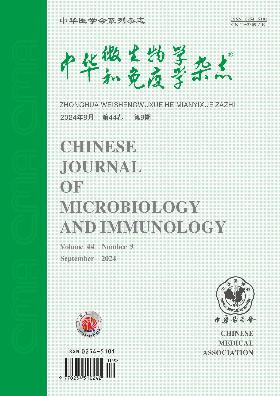Distribution and characteristics of heterogeneous vancomycin-intermediate Staphylococcus aureus in blood culture
Q4 Immunology and Microbiology
引用次数: 0
Abstract
Objective To investigate the epidemiological and molecular biological characteristics of heterogeneous vancomycin-intermediate Staphylococcus aureus (hVISA) in blood culture. Methods hVISA was detected using Mueller-Hinton agar containing 5 μg/ml of teicoplanin (MHA5T) and Populats profiles/area under the curve (PAP/AUC). Staphylococcal cassette chromosome mec (SCCmec), Staphylococcus aureus protein A (spa) and accessory gene regulator (agr) typing and multilocus-sequence typing (MLST) were analyzed using PCR. Difference in autolysis between hVISA and vancomycin-sensitive Staphylococcus aureus (VSSA) isolates were evaluated with Triton X-100-inducd autolysis. Expression of vraR, mgrA, icaA, icaR, pbp4 and agr genes in hVISA and VSSA strains were detected by real-time PCR. Results The positive detection rate of methicillin-resistant Staphylococcus aureus (MRSA) in blood culture was 39.5% (136/344) in our hospital. Among the MRSA strains, there were 31 strains of hVISA (22.8%). The minimum inhibitory concentrations (MIC) of vancomycin were mainly 1.5 μg/ml (54.8%) and 2 μg/ml(25.8%)against hVISA isolates, and 0.5 μg/ml (46.7%) and 0.75 μg/ml (39.0%) against VSSA isolates. The predominant clone of hVISA was ST239-SCCmecⅢ-t030-agrⅠ accounting for 71.0% (22/31). The autolysis of hVISA isolates decreased significantly as compared with that of VSSA isolates (χ2=13.583, P=0.032). Compared with VSSA strains, the expression of vraR, mgrA and icaA genes in hVISA strains increased by 1.58, 1.53 and 1.06 times (P<0.01), while the expression of icaR, agr and pbp4 genes decreased by 0.85, 0.61 and 1.03 times (P<0.05). Conclusions The prevalence rate of hVISA in our hospital reached 22.8% and the main epidemic clone was ST239-SCCmecⅢ-t030-agrⅠ, which should be paid great attention to clinically. Rational use of antibiotics, strengthening the prevention and control of nosocomial infection, and avoiding the spread of hVISA strains and the emergence of VISA and VRSA (vancomycin-resistance Staphylococcus aureus) were also necessary. Key words: Staphylococcus aureus; hVISA; Autolysis; MLST血液培养中异种万古霉素中间体金黄色葡萄球菌的分布及特点
目的探讨血液培养中异源性万古霉素中间体金黄色葡萄球菌(hVISA)的流行病学和分子生物学特征。方法用含有5μg/ml替考拉宁的Mueller-Hinton琼脂(MHA5T)和Populats图谱/曲线下面积(PAP/AUC)检测hVISA。应用聚合酶链式反应分析金黄色葡萄球菌盒染色体mec(SCCmec)、金黄色葡萄菌蛋白A(spa)和辅助基因调节因子(agr)分型和多点序列分型(MLST)。用Triton X-100诱导的自溶评价hVISA和万古霉素敏感的金黄色葡萄球菌(VSSA)分离株之间自溶的差异。通过实时PCR检测hVISA和VSSA菌株中vraR、mgrA、icaA、icaR、pbp4和agr基因的表达。结果我院血培养中耐甲氧西林金黄色葡萄球菌(MRSA)阳性检出率为39.5%(136/344)。MRSA菌株中有31株hVISA(22.8%),万古霉素对hVISA分离株的最低抑菌浓度主要为1.5μg/ml(54.8%)和2μg/ml(25.8%),对VSSA分离株的最小抑菌浓度分别为0.5μg/ml(46.7%)和0.75μg/ml(39.0%)。hVISA的优势克隆为ST239 SCCmecⅢ-t030 agrⅠ,占71.0%(22/31)。hVISA菌株的自溶性明显低于VSSA菌株(χ2=13.583,P=0.032)。与VSSA菌株相比,hVISA株中vraR、mgrA和icaA基因的表达增加了1.58、1.53和1.06倍(P<0.01),而icaR、agr和pbp4基因的表达减少了0.85,结论hVISA在我院的检出率达22.8%,主要流行克隆为ST239 SCCmecⅢ-t030 agrⅠ,临床应予以重视。合理使用抗生素,加强医院感染的预防和控制,避免hVISA菌株的传播和VISA和VRSA(万古霉素耐药性金黄色葡萄球菌)的出现也是必要的。关键词:金黄色葡萄球菌;hVISA;自溶;MLST
本文章由计算机程序翻译,如有差异,请以英文原文为准。
求助全文
约1分钟内获得全文
求助全文
来源期刊

中华微生物学和免疫学杂志
Immunology and Microbiology-Virology
CiteScore
0.50
自引率
0.00%
发文量
6906
期刊介绍:
Chinese Journal of Microbiology and Immunology established in 1981. It is one of the series of journal sponsored by Chinese Medical Association. The aim of this journal is to spread and exchange the scientific achievements and practical experience in order to promote the development of medical microbiology and immunology. Its main contents comprise academic thesis, brief reports, reviews, summaries, news of meetings, book reviews and trends of home and abroad in this field. The distinguishing feature of the journal is to give the priority to the reports on the research of basic theory, and take account of the reports on clinical and practical skills.
 求助内容:
求助内容: 应助结果提醒方式:
应助结果提醒方式:


